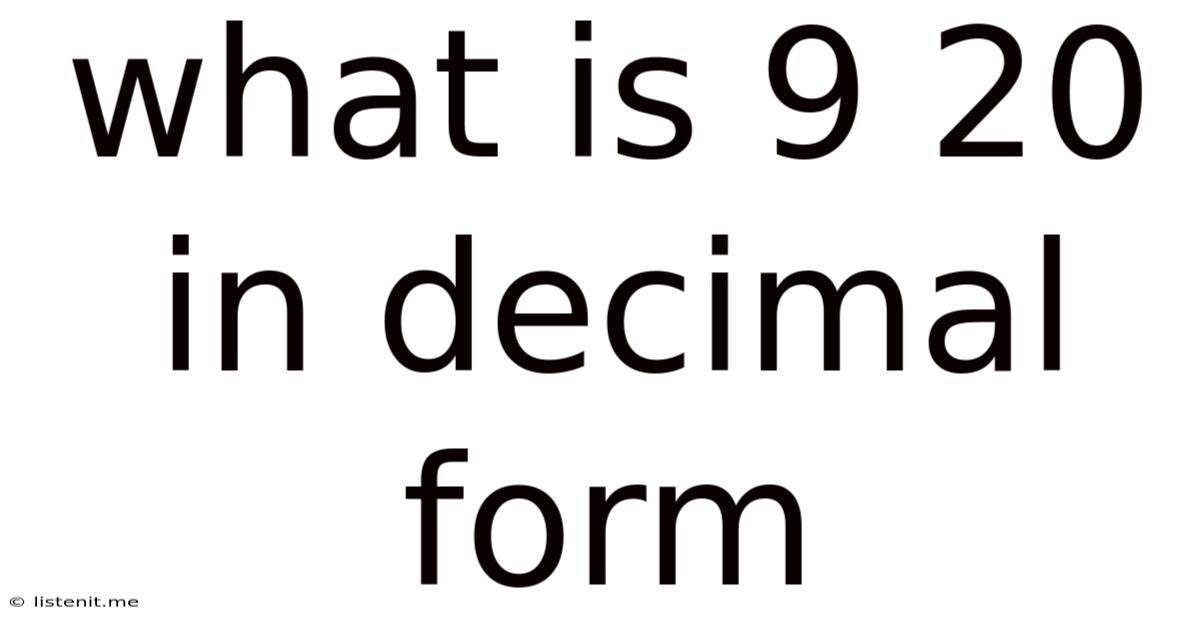What Is 9 20 In Decimal Form
listenit
May 10, 2025 · 4 min read

Table of Contents
What is 9/20 in Decimal Form? A Comprehensive Guide
The question "What is 9/20 in decimal form?" might seem simple at first glance. However, understanding the underlying principles of converting fractions to decimals offers a deeper appreciation of mathematical concepts and builds a strong foundation for more advanced calculations. This comprehensive guide will not only answer the question directly but will also explore the various methods for fraction-to-decimal conversion, providing you with the tools to tackle similar problems with confidence.
Understanding Fractions and Decimals
Before diving into the conversion process, let's briefly review the fundamentals of fractions and decimals.
Fractions: A fraction represents a part of a whole. It consists of two numbers: the numerator (the top number) and the denominator (the bottom number). The numerator indicates how many parts we have, while the denominator indicates how many equal parts the whole is divided into. For example, in the fraction 9/20, 9 is the numerator and 20 is the denominator. This means we have 9 parts out of a total of 20 equal parts.
Decimals: A decimal is another way to represent a part of a whole. It uses a base-10 system, where the numbers to the right of the decimal point represent tenths, hundredths, thousandths, and so on. For example, 0.5 represents five-tenths (5/10), and 0.25 represents twenty-five hundredths (25/100).
Method 1: Direct Division
The most straightforward method to convert a fraction to a decimal is through direct division. We divide the numerator (9) by the denominator (20).
9 ÷ 20 = 0.45
Therefore, 9/20 in decimal form is 0.45.
This method is simple and easily performed using a calculator or by hand using long division. Let's illustrate the long division process:
0.45
20 | 9.00
-8.0
1.00
-1.00
0
Method 2: Converting to an Equivalent Fraction with a Denominator of 10, 100, 1000, etc.
This method involves finding an equivalent fraction where the denominator is a power of 10 (10, 100, 1000, and so on). This allows for a direct conversion to a decimal.
To convert 9/20 to an equivalent fraction with a denominator of 100, we need to multiply both the numerator and the denominator by 5:
(9 × 5) / (20 × 5) = 45/100
Since 45/100 represents 45 hundredths, the decimal equivalent is 0.45. This method is particularly useful when dealing with fractions that have denominators that are factors of powers of 10 (like 2, 4, 5, 8, 10, 20, 25, 50, 100, etc.).
Method 3: Using a Calculator
The simplest and fastest method, especially for more complex fractions, is to use a calculator. Simply enter the numerator (9), then the division symbol (/ or ÷), then the denominator (20), and press the equals (=) button. The calculator will directly display the decimal equivalent: 0.45.
Practical Applications and Real-World Examples
Understanding fraction-to-decimal conversion isn't just an academic exercise; it has numerous practical applications in everyday life and various professions:
-
Finance: Calculating percentages, interest rates, discounts, and profit margins often involve converting fractions to decimals. For instance, a 9/20 discount means a 45% discount.
-
Measurement: Converting measurements from fractions of inches or centimeters to decimal equivalents is common in engineering, construction, and manufacturing.
-
Data Analysis: In statistics and data analysis, fractions are often converted to decimals for easier manipulation and interpretation.
-
Cooking and Baking: Recipes may use fractions, but precise measurements often require decimal equivalents.
-
Science: Many scientific calculations require the use of decimals, making the ability to convert fractions essential.
Troubleshooting Common Errors
While the conversion of 9/20 to 0.45 is straightforward, some common errors can arise when converting other fractions:
-
Incorrect Division: Ensure you divide the numerator by the denominator, not the other way around.
-
Decimal Point Placement: Carefully place the decimal point in the correct position in the resulting decimal.
-
Rounding Errors: When dealing with repeating decimals, decide on the level of precision required and round appropriately.
-
Improper Fraction Simplification: Always simplify the fraction to its lowest terms before converting to a decimal to avoid unnecessary complications.
Extending the Knowledge: Converting Fractions with Remainders
While 9/20 results in a terminating decimal (a decimal that ends), some fractions result in repeating decimals (decimals that continue infinitely with a repeating pattern). For example, 1/3 = 0.3333... Understanding how to handle repeating decimals is crucial for a complete grasp of fraction-to-decimal conversion. These are typically represented by placing a bar over the repeating digits, like 0.3̅.
Conclusion: Mastering Fraction-to-Decimal Conversions
The conversion of 9/20 to its decimal equivalent, 0.45, highlights the fundamental connection between fractions and decimals. By understanding the various methods – direct division, equivalent fraction conversion, and calculator usage – you gain the skills to handle a broad range of fraction-to-decimal conversions with accuracy and confidence. Remember to always double-check your work and be mindful of potential rounding errors. This thorough understanding forms a critical base for more advanced mathematical concepts and has wide-ranging practical applications across many fields. Mastering this skill empowers you to navigate numerical challenges with ease and efficiency.
Latest Posts
Latest Posts
-
1 Ml Is Equal To How Many Milligrams
May 10, 2025
-
Describe The Basic Differences Between Linear Growth And Exponential Growth
May 10, 2025
-
Which Statement Best Describes These Three Components Of Air
May 10, 2025
-
When The Pressure Of A Gas Is Raised Its Temperature
May 10, 2025
-
What Is The Factor Of 102
May 10, 2025
Related Post
Thank you for visiting our website which covers about What Is 9 20 In Decimal Form . We hope the information provided has been useful to you. Feel free to contact us if you have any questions or need further assistance. See you next time and don't miss to bookmark.